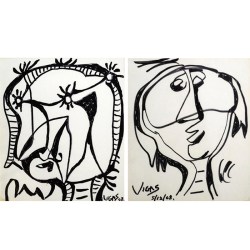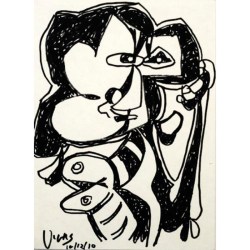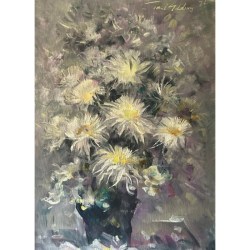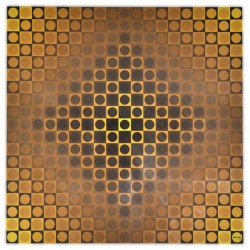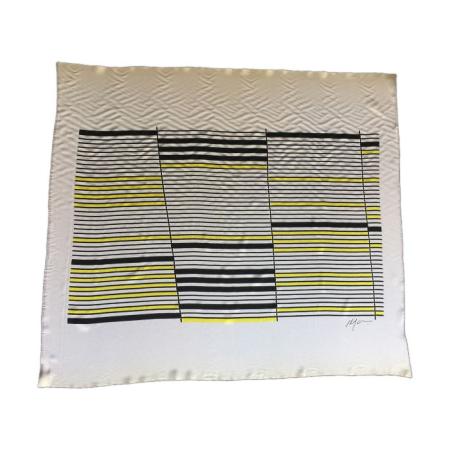Venezuelan Masters
Silk
1982
Signed
Provenance: acquired from Taller Cobalto; created in 1982
Alejandro Otero
Born March 7, 1921, in El Manteco, Venezuela, Alejandro Otero was a painter and sculptor who played a leading role in the history of modernist abstraction in his native land. From 1939 to 1945 he studied at the Escuela de Artes Plásticas de Caracas (School of Fine Arts of Caracas). Awarded a scholarship to move to Paris, he lived there between 1945 and 1952. It was in Paris that he began producing some of his most important bodies of work, including Las cafeteras (the Coffeepots), painted between 1946 and 1948, a series that marked his transition from figuration to abstraction. The canvases of this series were exhibited at the Museo de Bellas Artes (Museum of Fine Arts) in Caracas in 1949, an event that roused great controversy, opening the way for the emergence of geometric abstraction in Venezuela.
Upon his return to Paris in 1950, Otero founded the group Los Disidentes (The Dissidents, 1950) along with other young Venezuelan expatriate painters interested in abstraction. The group published a magazine of the same name that criticized the backwardness of the Escuela de Artes Plasticas, and the museums and salons of Caracas; it also asserted the artists’ identification with Paris and international artistic movements.
In 1955 Otero began to produce the Colorhythms, a series of modular paintings of Duco, an industrial lacquer, sprayed onto wood panels, with white and dark parallel bands, and vibrating forms of brilliant colors. In 1956 The Museum of Modern Art in New York acquired Colorhythm 1. Otero represented Venezuela at the Venice Biennale in 1956, and again in 1962 and 1966. In 1958, he was awarded the National Prize for Painting at the Venezuelan Official Salon for Colorhythm 35. He was included in the 1958 Pittsburg Bicentennial International Exhibition of Contemporary Painting and Sculpture at the Carnegie Institute, and in 1959 represented Venezuela in the São Paulo Biennial with the Colorhythms, receiving an honorable mention.
Otero moved to Paris a second time in 1960 and lived there until 1964. His works underwent changes, and he experimented with collage, assemblage, and objects trouvés. In 1963, he exhibited in the São Paulo Biennial, and, in 1966, Signals Gallery in London presented Otero’s first retrospective outside Venezuela, A Quarter of a Century of the Art of Alejandro Otero: 1940-1965. In the 1960s, Otero began to work on large-scale sculpture and ultimately produced outdoor public sculptures in Latin America, the United States, and Europe. In 1971, Otero received a fellowship from the John Simon Guggenheim Memorial Foundation and was a visiting artist at the Center for Advanced Studies of the Massachusetts Institute of Technology. During his tenure at MIT, he developed structural ideas for his sculptures. Retrospective exhibitions of his work were held at the Michener Galleries, University of Texas at Austin (1975); The Museo de Arte Moderno, Mexico City (1976); and the Museo de Arte Contemporáneo de Caracas (1985). Otero died in Caracas on August 13th, 1990.
AWARDS:
First Prize and Honorable Mention, Poster Contest, II Venezuelan Book Exhibition, Caracas, (1941)
Special Merit Award for Students of the School of Plastic Arts, III Annual Official Exhibition of Venezuelan Art, Museum of Fine Arts, Caracas, (1942)
Andrés Pérez Mujica Prize and Emilio Boggio Prize, III Arturo Michelena Hall, Athenaeum of Valencia, Carabobo State, (1945)
CAVA Award, IV Salon D'Empaire, Maracaibo, John Boulton Award, XVIII Annual Official Exhibition of Venezuelan Art, Museum of Fine Arts, Caracas. (1957)
National Painting Prize, XIX Annual Official Exhibition of Venezuelan Art, Museum of Fine Arts, Caracas, (1958)
Honorable Mention, V Biennial of Sao Paulo, (1959)
First Prize, II Inter-American Painting Salon, Barranquilla, Colombia, (1960)
National Prize for Applied Arts (shared with Mercedes Pardo), XXV Annual Official Exhibition of Venezuelan Art, Museum of Fine Arts, Caracas, (1964)
Enamel Prize (shared with Mercedes Pardo), International Exhibition of Artistic Crafts, Stuttgart, Germany, (1966)
Honorable Mention post-mortem, XXI Sao Paulo Biennial, (1991)
SOURCES:
Otero Pardo Foundation
ecured.cu
Available Artworks
Can’t find what you’re looking for?
We have access to a wide range of art collections to meet your requirements, ranging from Venezuelan & Latin American to international masters.
Contact us at +1 305 907-9960 regarding the artist you’re looking for; we’ll search and find it for you.
Starting your art collection
When starting a collection one must consider a variety of factors. First however, one must start by asking – why and how will I start to collect art?


